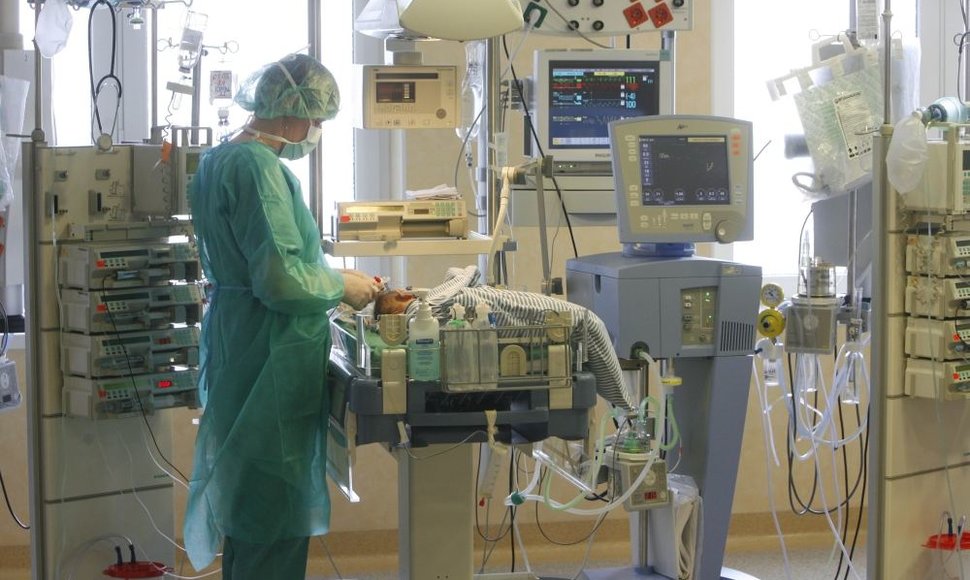Giving a new heart to baby Alantas, surgeons of Vilnius University Hospital had to demonstrate the highest level of excellence.
“It's an enormous achievement in the Baltic states with implications extending far to the East,” professor Vytautas Jonas Sirvydis, one of the country's most respected cardiac surgeons, spared no praise to his colleagues. “Transplant surgeries on infants are only performed in a handful of centres in the entire world, those specializing in paediatric medicine. It is much more difficult to prepare children for transplants than adults, it is more challenging to connect their bloodstream to artificial hearts. Therefore what was recently done in Lithuania is unique.”
Prof Sirvydis shares his impressions from a world heart surgeons congress that he recently attended. The high-point in the opening ceremony was a virtuoso performance by a ballet dancer. “When the soloist left the stage, they announced that the girl had underwent a heart transplant back when she was one year old,” says professor, his memory taking him back even further, to the times when Lithuanian medics could only dream about performing heart or kidney transplants.
Experiments on pigs
The first successful heart transplant, accomplished in South Africa in 1967, was met with huge media frenzy. Probably not a single newspaper in the world failed to report the sensational news in its pages. Lithuania was no exception.
The idea of transplanting hearts caught the imagination of cardiac surgery professor Algimantas Marcinkevičius. He stepped up experimentations in Vilnius, although a number of tests on dogs had been performed even before that.
“We would attach a puppy's heart to another puppy's groin or neck to observe if it would beat or not,” Prof Sirvydis recounts.
Despite excellent professional preparation, Lithuanian surgeons were not allowed to perform transplants on humans. Since Moscow was doing rather poorly in this area, surgeries were suppressed throughout the Soviet Union.
Many successful experiments involved pigs. Upon the consent from Vilnius Meat Factory director, an operating room was set up in one of its plants, where surgeons would work from dawn till dusk.
“We had transplanted hearts for over a hundred pigs. By 1969, we had perfected techniques and we were very well prepared for a real transplant. Prof Marcinkevičius set up an immunology lab, since we noticed that organ rejection was one of the gravest post-op problems,” says Sirvydis.
Despite excellent professional preparation, Lithuanian surgeons were not allowed to perform transplants on humans. Since Moscow was doing rather poorly in this area, surgeries were suppressed throughout the Soviet Union.
“Everything halted, yet our surgeons continued with experiments and waited for the right moment,” professor recalls.
Seventeen-year-old-donor
And a long wait it was. A breakthrough did not arrive until 1986, when the first successful heart transplant was performed in Moscow.
A few months later, an opportunity presented itself for Lithuanian surgeons to show their skill. On 1 September 1987, a seventeen-year-old girl, victim in a motorcycle accident, was declared brain dead.
Extensive testing determined that her heart was a match for Albinas Penkauskas, music teacher from Ukmergė. He was suffering from cardiomyopathy – condition affecting the heart muscle.
“By the time we had finished preparations for the surgery, it was 2 September – we opened Albinas up well after midnight. It took quite some time for Prof Marcinkevičius to convince the girl's grandmother that she would not recover – even though other vital organs were functioning, she was in fact dead. Eventually, the grandmother agreed to donate her granddaughter's heart,” Prof Sirvydis remembers events 25 years ago.
On that historic night, two teams of surgeons were working in the operating room under the leadership of Prof Marcinkevičius. One of them was removing the heart, the other – putting it in the recipient's chest.
The transplant itself took about an hour to perform, even though the entire surgery – from the first cut to the last stitch – lasted five and a half hours.
Undermined by infection
Penkauskas fully recovered after the first heart transplant in the country. He was strong enough to be able to walk, to talk to visitors and reporters, even to perform some music. The donor's grandmother also visited him several times in the hospital – she was particularly concerned about the patient's health, the two previously unfamiliar people formed a strong bond.
“We gave all our attention to this patient, doctors' meetings would be called every morning to discuss his condition. Over the two following months, Albinas regained so much strength that we even considered releasing him home, but one morning he suddenly passed out,” recounts Sirvydis.
We had to formulate the concept of organ donation, since there were no rules regulating it in the Soviet Union. We had to define what a donor was, what brain death was, etc.
After extensive testing, the patient was diagnosed with brain abscess. After two days in intensive care, Penkauskas died of infection-related complications.
“However, this case helped us move forward. We had to formulate the concept of organ donation, since there were no rules regulating it in the Soviet Union. We had to define what a donor was, what brain death was, etc. For that, we had to include neurologists, brain surgeons, anaesthesiologists, etc. There were many administrative issues to solve,” Prof Sirvydis lists initial problems.
Since then, there have been 104 heart transplant surgeries performed in Lithuania, 80 of them in Vilnius. At the moment, six people are on a waiting list, their lives supported by artificial hearts.
“According to global statistics, only one in ten patients in need of a heart transplant eventually get one. However, it gives great hope to a dying person,” professor believes.
Era of artificial hearts
Prof Sirvydis notes that medicine constantly advances and there are now alternative treatments. Much progress has been made in developing artificial hearts – these can extend a person's life for five or more years. During the time, there is an ever greater chance of finding a donor.
“Medical scientists are very ambitious in this area – they are developing fully-implantable artificial hearts with cables that supply energy from external batteries. They are working on a new kind of batteries that would only need to be recharged every few months or even once a year. In that case, an artificial heart could be a satisfactory alternative to transplant,” professor forecasts.
Another line of research looks into animals – specialists of genetics and tissue engineering are striving to modify immunology in certain animals so their organs are compatible with human body and are suitable for transplant.
“There have been cases of monkey liver transplanted to humans: in once case, it was functioning for several months, in another – for half a year. However, these are only experiments so far. Such surgeries are not performed in Lithuania,” he assures.
Children recipients
Santariškės Clinics of Vilnius University Hospital is the only centre in Lithuania and the Baltic states performing transplant surgeries on children. So far, heart transplants have been given to six kids. 3.5-month-old Alantas is the youngest of them, two others were a little over one year. The remaining three children were older. Three more kids are currently waiting for donors.
Globally, heart transplant surgeries on kids have been performed since 1982. There are 8,000 children included in the International Registry of Hear and Lung Transplantation. Most of them survived into adulthood.
The registry expands by around 400 new entries a year. 79 percent of transplant surgeries are performed in North America, 19 percent – in European medical centres, 2 percent – on other continents.
Around 25 percent heart transplant surgeries are performed on newborns and infants under one year old.
Survival rate after 1 month, 12 months, 5 years, and 10 years is 90, 85, 75, and 65 percent respectively.
Double anniversary
The first heart transplantation in the world was performed 45 years ago, in Lithuania – 25 years ago.
The father of heart transplant surgery is Stanford professor Norman Shumway. He has performed around 500 surgeries and developed a protocol that stands almost unchanged until now.
It was Shumway's pupil Christiaan Barnard who performed the first successful human heart transplantation in 1967 in Capetown.
Two teams of surgeons worked on the first heart transplantation in Lithuania. The first one – consisting of Salius Miniauskas, Vidmantas Žilinskas, Gediminas Norkūnas, Rimantas Karalius – operated on the donor. Prof Marcinkevičius headed the team operating on the recipient. He assembled a team of heart transplant surgeons who still work today. Back then, Marcinkevičius shared the room with Sirvydis and Giedrius Uždavinys. They were joined by Miniauskas and Žilinskas, who came in carrying the donor heart. Also in the team were anaesthesiologists Alis Baublys, Algimantas Matulionis, and Gediminas Martinkėnas.















